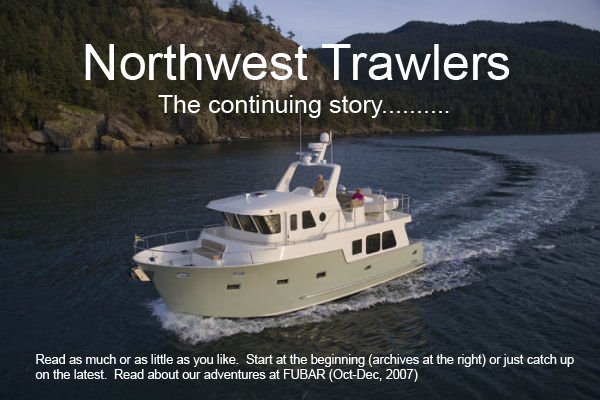It was last year that we began to think about offering full displacement hull forms as an option for our Northwest Trawler line. Essentially, keep the basic Northwest Trawlers styling above the waterline but design the hull so that it could be easily built as a semi-displacement or full displacement hull.
Our designer, Steve Seaton, was tasked with making the subtle hull shape changes that would allow this. Our original idea was to build the tooling so that it split horizontally above the waterline and you simply bolted on the hull bottom type that you were building. It would be easy to have the boat built either way at the same yard.
It sounded like a great idea.
But then I began to ponder if FRP (fiberglass) was really the right choice for an offshore (ocean crossing) cruising hull. I recalled the numerous times that I have been running offshore in the middle of the night or in reduced visibility and had the thought strike me, "gosh, I hope we don't run into something we can't see". It is a sobering thought (not that I would be drinking while underway, mind you). But when you are hundreds of miles from land and you are totally self reliant for survival, you want to be confident that your ship (as small as it may be) is built of the strongest, most puncture resistant material available. Just in case!!! Then thinking of inadvertently running up on a reef and wave action grinding the fiberglass away while trying to extricate the boat.........hmmmmmm...
I began to waffle on FRP as a viable hull material for serious offshore cruising.
Then the tragic Japanese tsunami occurred and I began reading reports of debris, large debris, maybe even overturned fishing vessels, containers, and other large objects that are predicted to be orbiting around the Pacific Ocean for the next 5-10 years.
That sealed my decision......no FRP hulls for our full displacement expedition series. Steel it would be....with FRP or aluminum for the superstructure to keep the weight down.
Steel is actually easier to build with. It requires no tooling for the hull and with today's modern coatings, it can be as easy to care for as fiberglass.
So beginning with our 2012 models (available for order now), we will offer Northwest Trawlers in a steel hulled configuration for the:
NW48FD, NW52FD, NW58FD, NW64FD, NW72, and the newly designed NW88.(the FD designates full displacement.
Of course for coastal and near coastal cruising (not ocean crossing), which is what most people do, we still recommend our semi-displacement, performance trawlers; the NW48, NW52, NW58, and NW64. All of our FRP hulled trawlers have Kevlar in the forward sections for strength and puncture resistance.
And now, due to Steve Seaton's brilliance (Steve are you listening???), we now offer all of our models in either single engine or twin engine configurations. You can opt for single engine, displacement speeds for economy, or you can up-size your single engine or "twin" your semi-displacement hulled Northwest Trawler and achieve top speeds in the high teens.
So if your cruising plans are for weekend getaways, summer cruises up the Inside Passage, Caribbean adventures, or crossing an ocean, we are confident that Northwest Trawlers can provide you a trawler or expedition yacht to meet your needs and exceed your expectations.
Wednesday, May 11, 2011
Subscribe to:
Comments (Atom)




